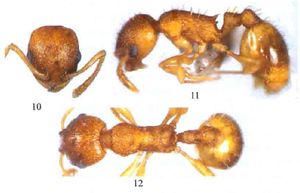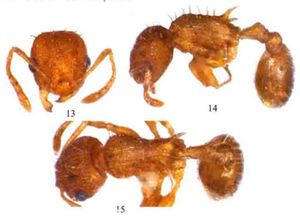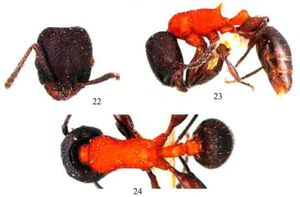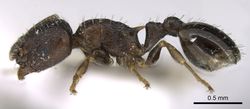Key to Temnothorax of mainland China
This key to workers of Temnothorax known from China is based on Zhou et al. (2010) as modified by Hamer et al. (2023).
Zhou et al. note: The species Temnothorax spinosior that many Chinese authors have reported in Southern China belongs to Temnothorax taivanensis. T spinosior is distributed over Central, Northern and North-Western China.
1
2
return to couplet #1
- Antennae 11-segmented; humeri slightly angulate (Hubei) => Temnothorax koreanus
- Amennae 12-segmented; humeri strongly angulate => 3
3
return to couplet #2
- Antennal scape longer (SI1 > 0.86, SI2 > 0.96), pronotum in profile strongly convex, its anterior face steeply inclined forward, color yellowish-brown (Hunan) => Temnothorax angulohumerus
- Antennal scape shorter (SI1, < 0.80, SI2 < 0.93), pronotum in profile gently convex, color dark brown (Yunnan) => Temnothorax orchidus
4
return to couplet #1
- Propodeum unarmed, forming a blunt angle between dorsum and declivity (Hunan) => Temnothorax hengshanensis
- Propodeum with spines, or denticks, or acurely triangular => 5
5
return to couplet #4
- Propodeum acutely triangular; occipital border and middle frons of head with indistinct longitudinal rugulosity, appearing smooth; pronotum with central plate smooth (Guangxi ) => Temnothorax maoerensis
- Propodeum with spines; dorsum of head and pronotum sculptured or punctuate, appearing dull => 6
6
return to couplet #5
- Propodeum with short spines or with sharp denticles only, ESLI < 0.28 => 7
- Propodeum with long, sharp spines, ESLI > 0.33 => 14
7
return to couplet #5
- Whole body concolorous reddish-brown to black => 8
- Mesosoma yellow to brownish-yellow, contrasting with darker head and gaster, or whole body concolorous ochreous-yellow => 9
8
return to couplet #7
- Petiolar node in profile with wide, slightly convex dorsal plate. Frons with longitudinal rugae and coarse punctures, remaining part of dorsum of head punctuate. Antennae and legs of the same color as body (Yunnan, Guangxi) => Temnothorax congruus
- Petiolar node in profile very narrowly rounded, subtriangular. Dorsum of head only finely and densely punctuate, striation present only near eyes; a central longitudinal band on Frons smooth and shining. Antennae and legs yellowish, contrasting with much darker body (Beijing, Hebei, Hunan) => Temnothorax wui
9
return to couplet #7
- Whole body concolorous ochreous-yellow => 10
- Mesosoma yellow to brownish-yellow, contrasting with darker head and gaster => 11
10
return to couplet #9
- Propodeal spines shorter, ESLI <0.20; Petiole lower, PI < 1.30, petioiar node with widely rounded dorsum; dorsum of mesosoma with longitudinal striations (Ningxia, Hubei, Henan) => Temnothorax striatus
- Propodeal spines longer, ESLI > 0.24; Petiole higher, PI > 1.45, petiolar node with narrowly rounded dorsum; dorsum of mesosoma with coarse reticulations (Shannxi) => Temnothorax shannxiensis
11
return to couplet #9
- First gastral tergite coarsely punctuate, opaque (Ningxia) => Temnothorax mongolicus (as junior synonym Leptothorax opaciabdomin)
- First gastral tergite not punctuate, smooth and shining => 12
12
return to couplet #11
- Dorsum of head densely longitudinally striate (Ningxia) => Temnothorax brevispinus
- Dorsum of head densely punctuate => 13
13
return to couplet #12
- Mesosoma and waist ochreous-yellow to brownish-yellow, dorsum of head of the same color as mesosoma, gaster brown with basal one-fourth of first tergite yellow (Liaoning, Heilongjiang, Hebei, Shannxi) => Temnothorax pisarskii
- Mesosoma and waist ochreous-yellow to brownish-yellow) dorsum of head brown, distinctly darker than mesosoma, gaster entirely brown, without pale spot at base of the first tergite (Hebei) => Temnothorax mongolicus
14
return to couplet #6
- Whole body concolorous ochreous-yellow => 15a
- Body reddish-brown to dark brown or bicolored, with mesosoma distinctly lighter than head and gaster => 16
15a
return to couplet #14
- Dorsum of head and mesosoma predominately glabrate; mesosoma outline with mesopropodeal depression present and conspicuous (Hong Kong) => Temnothorax haveni
- Dorsum of head and mesosoma not predominately glabrate; mesopropodeal depression absent => 15b
15b
return to couplet #15a
- Size larger, WL > 1.5; dorsum of head and mesosoma longitudinally rugose or striate (Hunan) => Temnothorax ruginosus
- Size smaller, WL < 1.0; dorsum of head and mesosoma not longitudinally rugose or striate => 15c
15c
return to couplet #15b
- Dorsum of head densely punctuate; mesosoma dorsum densely punctuate (Zhejiang) => Temnothorax zhejiangensis
- Dorsum of head areolate-rugose; mesosoma dorsum scarcely punctuate, few punctae scattered between areolae (Hong Kong) => Temnothorax barrettoi
16
return to couplet #14
- Mesosoma and waist o range, head and gaster reddish-black; occiput with transverse coarse rugosities (Guangxi) => Temnothorax leyeensis
- Mesosoma and waist yellow to brownish-yellow, dorsum of head and gaster brown to dark brown or whole body concolorous reddish-brown to dark brown; occiput without transverse coarse rugosities => 17
17
return to couplet #16
- Mesosoma yellow to brownish-yellow, dorsum of head and gaster brown to dark brown => 18
- Whole body concolorous reddish-brown to dark brown => 21
18
return to couplet #17
- Propodeal spines in dorsal view curved inward (Sichuan) => Temnothorax reduncus
- Propodeal spines directed backward and outward, not curved inward in dorsal view => 19
19
return to couplet #18
- Striations on frons coarse; Petiolar node in profile with angular dorsal plate, not massive (Beijing, Hebei, Liaoning, Henan, Shannxi, Ningxia, Fujian, Guangxi) => Temnothorax argentipes
- Striations on frons fine; petiolar node in profile with rounded dorsal plate, massive => 20
20
return to couplet #19
- Longitudinal striations on frons of head reaching occiput; propodeal spines sharp (Beijing, Shannxi) => Temnothorax nassonovi
- Longitudinal striations present on frons of head, occiput reticulate; propodeal spines blunt or even truncate (Ningxia) => Temnothorax reticulatus
21
return to couplet #17
- Petiole with long anterior peduncle (PI > 1.75), anterior face in profile strongly concave (Hunan, Fujian, Guangdong, Guangxi, Hainan) => Temnothorax taivanensis
- Petiole with short anterior peduncle (PI < 1.6), anterior face in profile very weakly concave => 22
22
return to couplet #21
- Propodeal spines shorter (ESLI < 0.43). Petiole relatively lower and longer (PI > 1.50), petiolar node massive, with broadly rounded dorsum. Antennal scape somewhat shorter (SI1 <0.75, SI2 <0.90) (Beijing, Hebei, Heilongjiang, Shandong, Henan, Shanxi, Shannxi, Ningxia, Hubei, Hunan) => Temnothorax spinosior
- Propodeal spines longer (ESLI > 0.49). Petiole relatively higher and shortet (PI < 1.40), Petiolar node less massive, with narrowly rounded dorsum. Antennal scape longer (SI1 > 0.75, SI2 > 0.90) (Jiangxi) => Temnothorax eburneipes
References
- Hamer, M. T., Lee, R. H., Guénard, B. 2023. First record of the genus Temnothorax Mayr, 1861 (Formicidae: Myrmicinae) in Hong Kong, with descriptions of two new species. European Journal of Taxonomy 879, 116-135 (doi:10.5852/ejt.2023.879.2165).
- Zhou, S., Huang, J., Yu, D., Liu, Z. 2010. Eight new species and three newly recorded species of the ant genus Temnothorax Mayr (Hymenoptera: Formicidae) from the Chinese mainland, with a key. Sociobiology. 56(1):7-26.

















